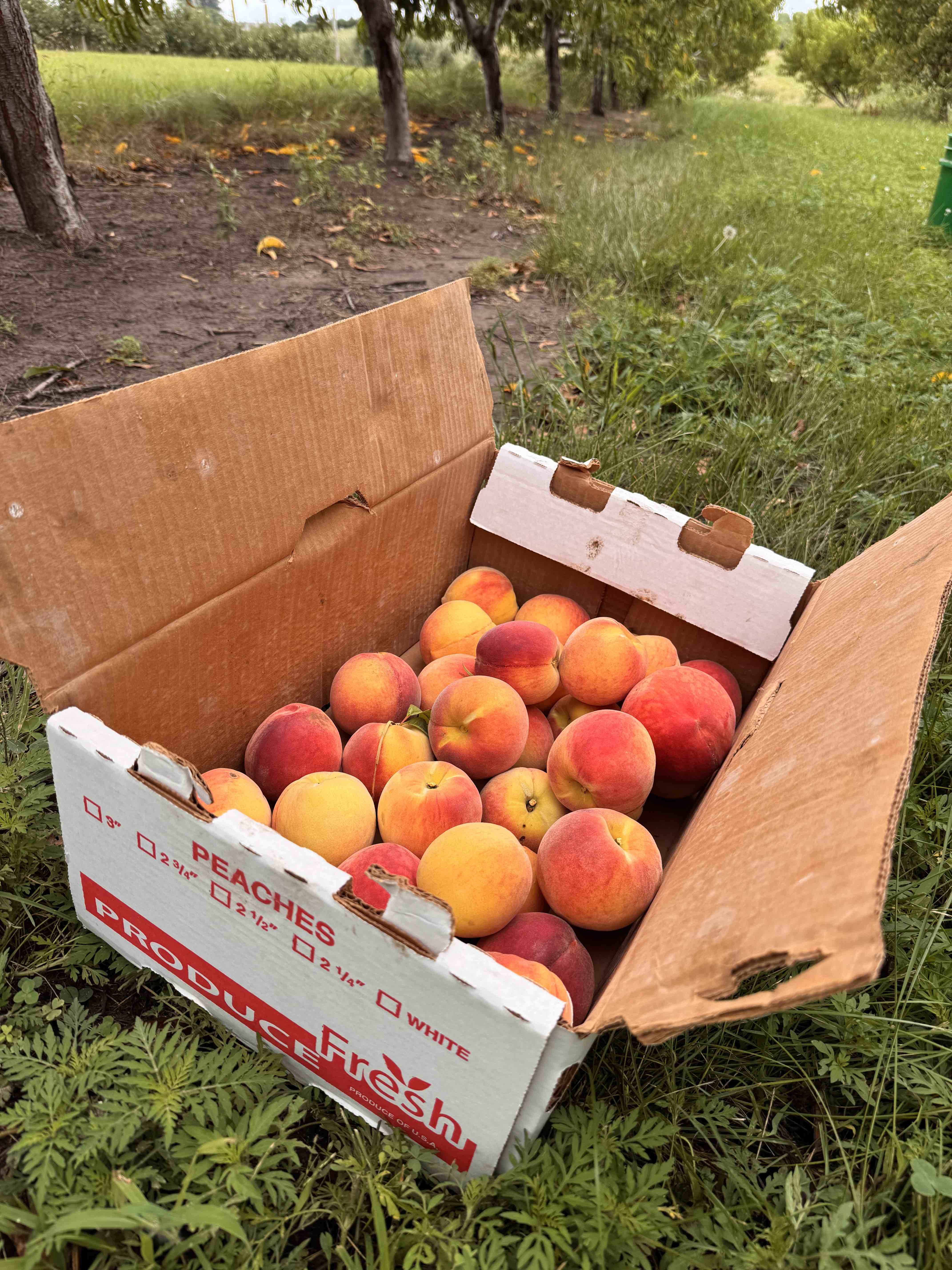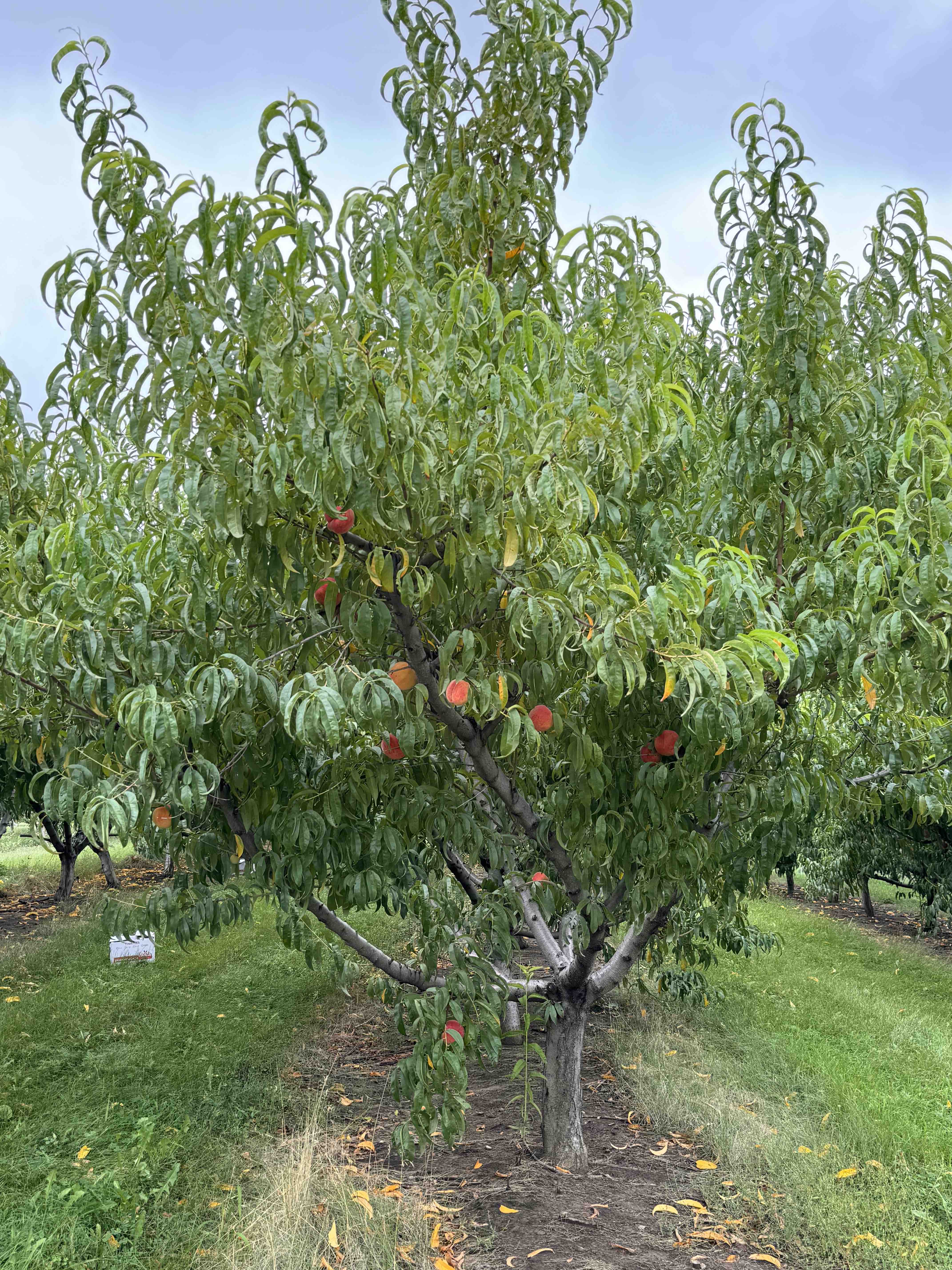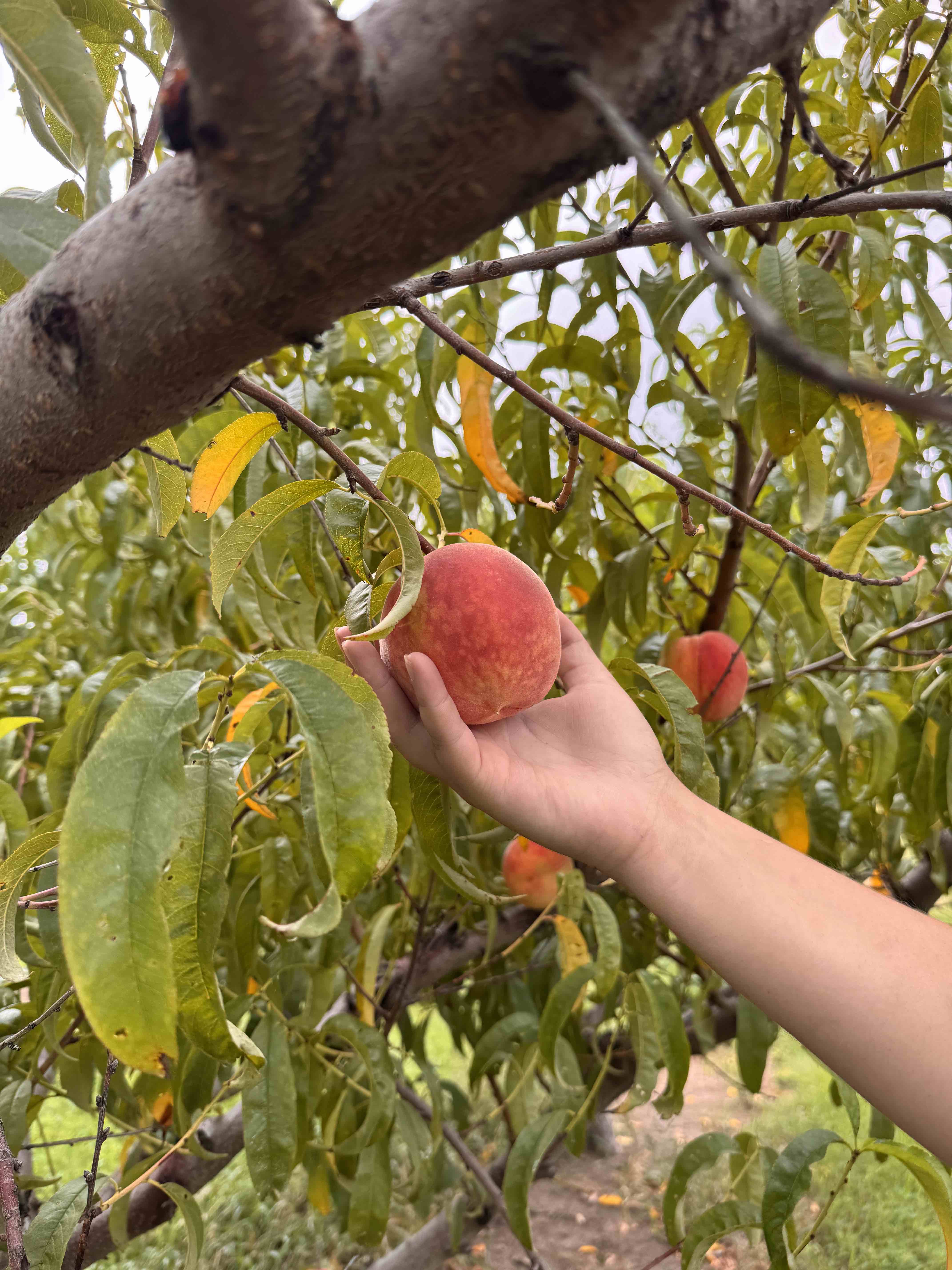by Trey Lamkins, Landscape Operations, Kimmel Education and Research Center
A Peach Season We Didn’t Expect
If you had asked us at the start of the growing season whether we’d have peaches in 2025, our answer would have been: probably not. A warm stretch in late winter followed by a sharp cold snap and frost left us bracing for disappointment. Peaches are notoriously sensitive to late freezes. It only takes one ill-timed cold front to ruin a whole crop.
But to our surprise, the trees pulled through. Many of the peach blossoms weren’t as damaged as we feared, and against the odds, they set fruit. In July, our Orchard Team, led by Jesse Mendez and co-managed by Emma Frederick and Caleb Wehrbein, wrapped up the harvest of this year’s peach crop. It wasn’t the biggest season, but with over 3,500 pounds of fruit harvested, we’re calling it a true Christmas in July!
At Kimmel Orchard, we have grown several peach cultivars that have contributed to the sweet, juicy harvest this season, and they are currently available in our store, the Apple Barn! If you haven’t had a chance to stop by over the past couple of weeks, no worries, there’s still time to enjoy fresh, Nebraska-grown peaches while they last.
This time of year, we always get the same question from curious fruit lovers:
Can you really grow peaches in Nebraska? The short answer is yes. The longer answer? It depends, and that’s what we’re here to explore. With insights from Nebraska Extension professionals and a few lessons from the orchard, let’s dig into what it takes to grow peaches in the Cornhusker State or nearby regions.

Peaches in the Heartland: A Balancing Act
Growing peaches in Nebraska comes with a fair share of challenges. As Sarah Browning, Nebraska Extension Educator, explains: “Growing peaches and apricots in Nebraska is a challenge, but still many gardeners are successful.”
The hurdles are real! Late frosts, unpredictable weather, short tree lifespans (often only 8–10 years), and pressure from pests and diseases. Yet, with careful planning and a willingness to accept occasional setbacks, peaches can thrive here. The key is understanding the purpose, place, and plant.
Before you plant, ask:
What is your goal: fruit production, pollinator value, shade, education?
Does your site meet the plant’s needs?
Do you know the cultivar’s strengths, weaknesses, and growing requirements?
Location, Location, Location
One of the most critical factors in growing peaches is site selection. As Elizabeth Exstrom, Extension Educator, puts it: “The words location, location, location have never been more important than with the site for your fruit trees.”
Peach trees need full sun (at least 8 hours per day) and good air circulation. Avoid low-lying areas prone to frost, and steer clear of south-facing slopes that warm up too quickly in spring. Kim Todd, UNL Professor and Extension Specialist, also recommends planting on north or northeast slopes, which warm more slowly and can delay bloom, helping protect flowers from damaging frosts. “Protecting peach trees from desiccating winds with other plants can also help,” she adds.
And don’t forget the soil. Drainage is key. Mulch around the base of the tree or use low-competition groundcovers to protect roots and retain moisture.
Choosing the Right Cultivars
Not all peach trees are created equal, especially when it comes to Midwest hardiness. Here at Kimmel, some of the cultivars we have had success with include:
Red Haven – A classic, with a juicy, excellent flavor, this variety is a tasty snack and fantastic for canning and baking.
Klondike – a white-fleshed peach that provides a memorable low-acidic flavor. Its large size and lively coloring make this variety a favorite for fresh eating.
Flaming Fury Series – A lineup of large, vibrant, juicy, sweet peaches that ripen across several weeks. These varieties produce large-sized fruits perfect for baking and fresh eating.
Kim Todd recommends Contender and Red Haven for home growers in Nebraska due to their hardiness and flavor. She also notes that some growers have had success with the unique Flat Saturn peach, which produces sweet, donut-shaped fruit.
“Reliability is key when selecting a cultivar,” says Todd. “Contender is a good one, tasty and reliable. Red Haven is also a good one.”
Pruning for Productivity
Peaches require annual pruning to remain productive and healthy. According to Kim Todd, “peaches produce on one-year wood—reddish in color—not on the older gray wood.” This means regular pruning ensures new fruiting wood develops each year.
She recommends the following Best practices:
Shaping trees with 2 to 4 scaffold branches in an open center or “V” formation.
Maintaining branches in the 3' to 8' height range for easy harvesting and allowing light exposure and air to reach the interior canopy.
Pruning during the winter months when the tree is still in dormancy to improve airflow and reduce disease pressure.
“Pruning prevents more problems than pesticides or insecticides,” Todd adds. “Good structure and sunlight are your best defenses.”

When—and How—to Harvest
In our region, peaches typically ripen from late June through August, depending on the variety and weather. Timing your harvest is crucial—peaches don’t ripen or sweeten once they’re picked.
Look for:
A shift in background color from green to golden yellow.
A slight give when gently squeezed.
Don’t rely on the red blush—it's not an indicator of ripeness.
Once picked, peaches should be consumed or preserved quickly. They keep best at 31–32°F with high humidity, but their shelf life is short, 2 to 4 weeks at most.

Managing Pests and Wildlife
Unfortunately, you won’t be the only one eyeing those ripe peaches.
Though we appreciate, understand, and value their importance, birds such as robins, orioles, and grackles often go after ripening fruit. Which is a problem for those of us who also want the fruit! Some suggest trying bird netting and monofilament lines in a teepee shape over the tree to help deter them.
Insects can also be an issue. Japanese beetles, plum curculio, and two types of peach tree borers are common pests. For high-quality, grocery-store-level fruit, a spray program may be necessary but many backyard growers are willing to accept a few blemishes in exchange for reducing chemical inputs.
Don’t forget about the other threats. “Raccoons, squirrels, birds, and even passersby will ‘borrow’ fruit,” Todd grinningly noted.
Want to Grow Your Own? Start Here.
Thinking about planting a fruit tree? In Nebraska, peaches might not be the easiest or best option but if you’re set on growing one, it’s possible with the right planning, site selection, and a bit of patience. With expert guidance from Nebraska Extension and Backyard Farmer, you’ll be off to a strong start.
Here are some great resources to help:
Selecting Fruit Trees for Eastern Nebraska - Nebraska Extension in Lancaster County
Fruit Trees for Nebraska – Nebraska Extension - HUSKER HORT
Growing and Harvesting Peaches & Apricots – Nebraska Extension in Lancaster County
Backyard Farmer Video Library (Just search “peach” for expert how-to content)
Fruit and Vegetable Resources - Backyard Farmer
Landscapes: Trees, Shrubs, and Flowers Resources - Backyard Farmer
Pruning Fruit Trees - Nebraska Extension
Fruit Tree Cultivars for Nebraska - Nebraska Extension
Still have questions? Come visit us at Kimmel Orchard & Vineyard or submit your question to Backyard Farmer, we’d all be happy to chat about fruit with you!
In conclusion, growing peaches in Nebraska takes knowledge, care, and sometimes a little luck. But in the words of Dr. Robin Wall Kimmerer, “In some Native languages the term for plants translates to ‘those who take care of us.’” When we care for our trees, they return the favor, with food, beauty, and a deeper connection to place.
Though peaches aren’t native to our region, let’s not discount their value. They offer a unique opportunity to provide for our communities.
Let’s Stay Connected: Follow Along and Share Your Story
Do you grow peaches at home? Have a favorite peach cobbler recipe or a family recipe passed down through generations? We’d love to hear about it!
Tag us on social media @KimmelOrchard and @byfunl, or message us directly.
Find Everything Kimmel Related via our Linktree!
Kimmel Education and Research Center
5985 G Rd., Nebraska City, NE 68410 (402-873-5293) info@kimmelorchard.org
Business Hours - Kimmel Education and Research Center:
Sunday: CLOSED
Monday-Friday: 8 AM- 5 PM
Saturday: CLOSED
Apple Barn Store - Kimmel Orchard and Vineyard
5995 G Rd., Nebraska City, NE 68410 (402-873-5293) info@kimmelorchard.org
Business Hours - Apple Barn:
Sunday: 11 AM- 5 PM
Monday: CLOSED
Tuesday: CLOSED
Wednesday: 10 AM-6 PM
Thursday: 10 AM-6 PM
Friday: 10 AM- 6 PM
Saturday: 9 AM- 5 PM

